

Home
About Us
Allotments
Garden Equipment
Seed Suppliers
Manure Problems
Children's Pages
GLA Blog
Weather Blog
School Veg Patch
Useful Links
Biodiversity
Our attempts at creating a biodiverse plot and garden
For me part of the joy of having a garden or being at the plot is to share the environment with nature.
By encouraging biodiversity not only does it make life more interesting but a balance is created. A haven is also provided for the many plants and creatures that struggle to find a home in our increasingly sterile 'wild' environment. Gardens and allotments can provide green corridors and a lifeline for our native wildlife.
Allotments and gardens don’t need to be intensively cultivated in the way farmland often is. The fact that more people are keen to encourage wildlife to share their gardening spaces is shown by the increase in the sales of wildlife friendly products and habitats.
At one time gardeners saw wildlife as a threat to be kept at bay. Allowing wildlife into gardening spaces was thought to encourage a platoon of creatures that would destroy anything that you tried to grow. Gardeners resorted to a whole arsenal of chemical controls that killed off everything whether it posed a threat or not. Not only were the pests killed but also those creatures that would prey on them. Pests developed immunity to some chemicals and so stronger potions were developed. In some cases the pests tolerated the chemical controls but the beneficial insects didn’t. Some pests freed from the creatures that preyed on them flourished. Encouraging a natural balance will not rid your garden or plot of pests but it will help keep them under control. There will be times when you may still need to intervene but this can be done in a way that is sympathetic to beneficial wildlife.
The first major decision to be made if you wish to encourage biodiversity is to stop using chemicals indiscriminately. At first this will inevitably lead to an increase in pests so you will need to do as much as you can to encourage beneficial creatures into your gardening spaces by providing them with the type of habitat and additional food supply that they seek. On many allotment sites an area is managed as a wildlife area but if this isn’t the case on your site you can create wildlife friendly spaces on your own plot.
So what do we do on our plot and in our garden?
Water
Water is essential for all wildlife. Birds in particular need a constant supply not only for drinking but also for bathing in order to keep their feathers in good condition. Ponds will encourage amphibians and some invertebrates to take up residence.
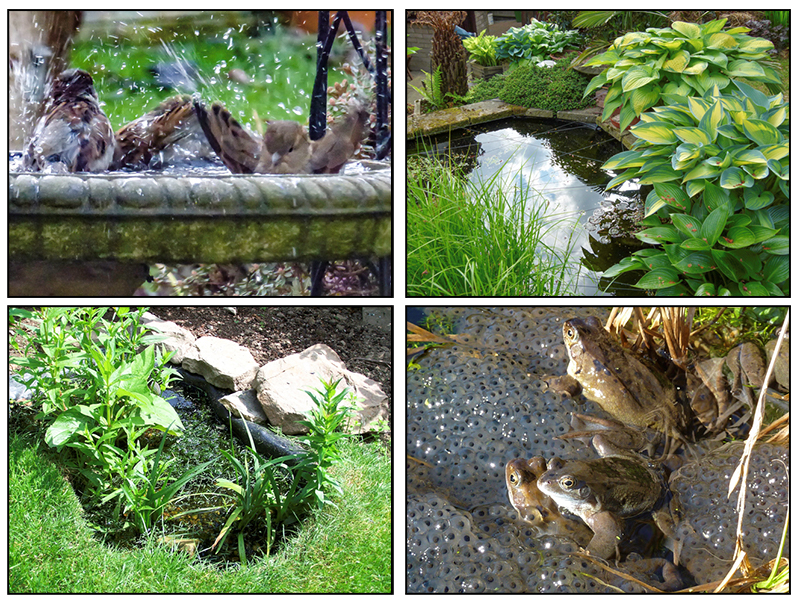
Plot:
On our site several allotment holders have small ponds and we are also lucky in that we are situated close to areas of open water. These conditions mean we have an abundance of frogs, toads and newts and also some dragonflies. A small pond area could well be in our future plans though!
It is important to cover water butts to prevent birds from falling in and drowning.
Garden:
In our garden we have a pond, a few bird baths and what I call a large puddle. The puddle is a very small wildlife pond. We added this as the main pond, being surrounded by a small wall, is less accessible to wildlife such a hedgehogs. Despite that each year it attracts breeding frogs and a whole host of bird species visit to drink and bathe especially in winter when the bird baths quickly freeze.
Hedges and Fedges
These provide nesting and hiding places for a variety of birds. Berries provide food for birds and small mammals and many flowers provide food for insects. Hedges and fedges also provide protected corridors along which wildlife can travel. Hibernating animals can also find shelter at the base of a hedge.
Plot:
Again we are fortunate in that along two of our site boundaries there are natural hedges which include hawthorn, bramble and elder. Another side is bounded by a tall leylandii hedge.
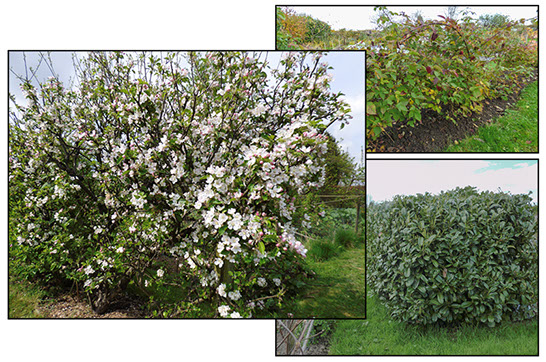
A friend was digging up some small plants which she didn’t want to throw away and which we thought would make a good wind break. We now have an established hedge which is a very popular nesting site. Blackberries, kiwi and tayberries are trained along fences.
Tayberries create quite a thicket during the growing season. Not only do the insects love visiting the flowers but birds and small creatures also share the berries with us. Some butterfly caterpillars such as those of the gatekeeper feed on grass. Adult gatekeepers are attracted to blackberry flowers and so this species is seen in this area in abundance.
Butterflies often sit sunning themselves on the leaves and when flowering the canes are buzzing with feeding bees.
Our apple edge is a good source of nectar and also provides good foraging for insect eating birds.
Garden:
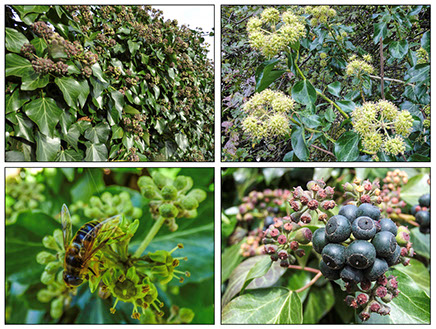 Although we don’t have hedges in our garden we have shrub borders which have a similar function and all our fences are covered with climbing plants including ivy, honeysuckle and pyracantha all excellent wildlife plants.
Although we don’t have hedges in our garden we have shrub borders which have a similar function and all our fences are covered with climbing plants including ivy, honeysuckle and pyracantha all excellent wildlife plants.
A shrub border also mimics the conditions that a hedge would provide.
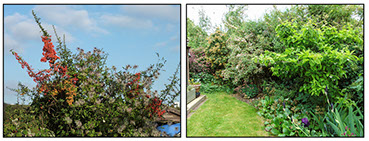
Shrubs and Trees
Shrubs and trees can take the place of a hedgerow. Prickly or evergreen bushes provide protection for birds and small mammals - evergreens being especially important during winter months. Add to this berry bearing plants and you are also offering birds and small mammals a food supply. Nectar rich flowering shrubs also provide sustenance for invertebrates. Trees offer birds a safe place in which to perch.
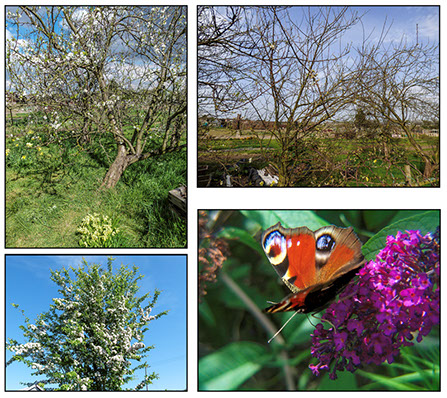
Plot:
As well as fruit trees and bushes we also have a hawthorn tree which was trained from a seedling that arrived courtesy of a passing bird. At the end of some beds we have also planted ornamental shrubs – mainly buddleia which is so popular with butterflies and bees. These were planted when I had too great a success at rooting some cuttings for the garden and didn’t want to throw the extras away.
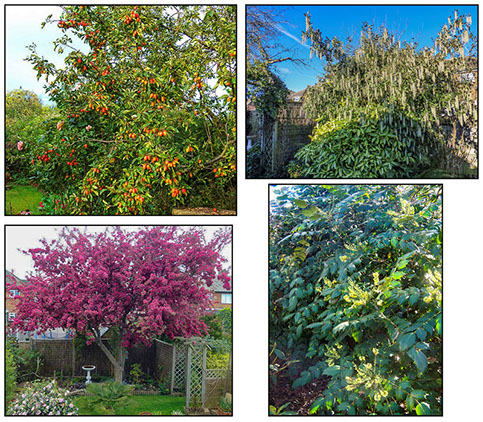
Garden:
As mentioned above we have lots of mature shrubs in the garden but we also have a couple of crab apple trees and a magnolia. Birds are often seen foraging under mature shrubs and they like be able to perch high up in trees. The area under shrubs is often protected from frost and snow and offers birds and small mammals a hunting ground when the rest of the soil is either frozen or covered in a blanket of snow. Flowering shrubs and ones which produce berries provide food for birds, butterflies and bees.
Leaf Litter and Mulches
Not only do the leaves decompose to improve the soil but leaf litter and mulches provide good foraging for birds and ideal conditions for hibernating invertebrates and larger creatures such as hedgehogs. On the downside, for the gardener, mulches also provide hiding places for slugs and snails!
Plot
Around the base of some fruit bushes and trees is a mulch of wood chippings.
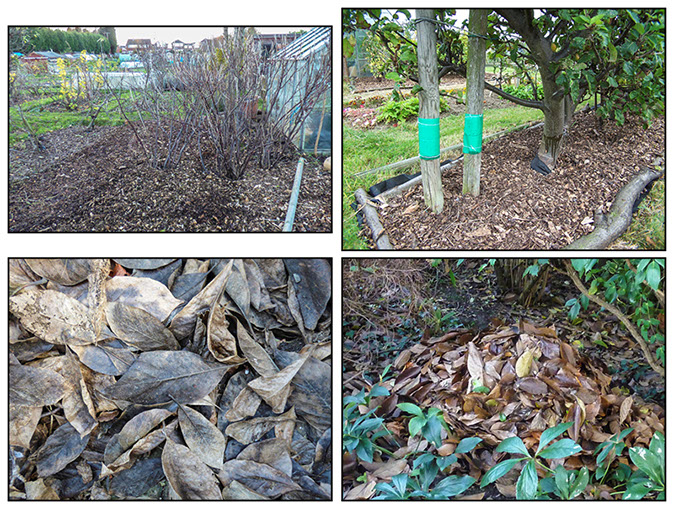
Garden
Leaves from deciduous plants are allowed to remain on the ground or piled under shrubs producing a carpet of leaf litter over winter and shelter for hibernating creatures such as hedgehogs.
Digging
Digging disturbs the larvae of many predatory beetles which overwinter in the soil.
Plot
Avoiding digging isn’t really an option on most of our plot although areas around fruit trees, fruit bushes and shrubs are left more or less undisturbed. Also the grass paths mean that there a re quite large areas where the soil is undisturbed. Digging can however have a positive effect in that it uncovers the eggs of slugs and snails and other soil bound pests. and sharp eyed birds soon swoop down for a meal.
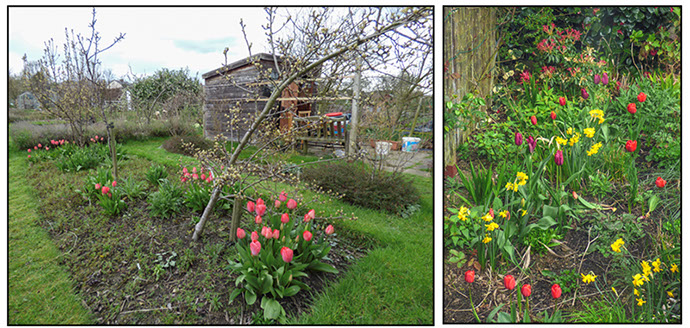
Garden
Many areas of our garden are permanently planted and so dug only infrequently.
Grass
Different lengths of grass provide habitats for different types of creatures.
Plot
Beds are surrounded by grass paths which encourage ground beetles. They are voracious predators of slugs and so are well worth encouraging. Grass is also left a little longer around the bases of fruit trees. In other areas of the plot grass is allowed to grow long and to produce flowers. Butterflies such as gatekeepers frequent this type of habitat.
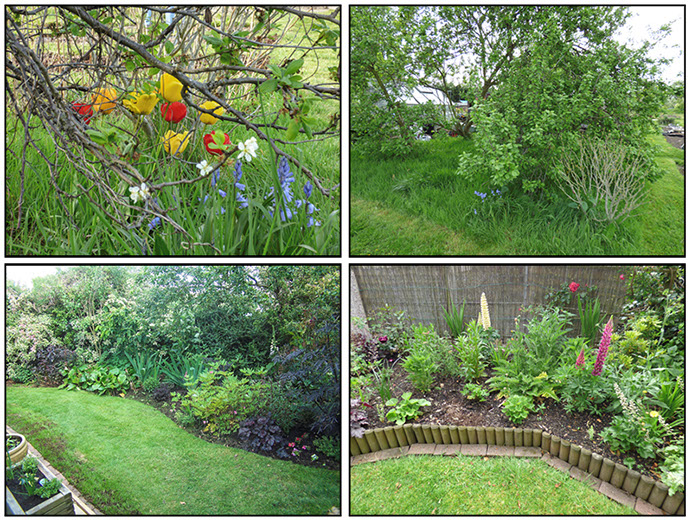
Garden
Lawn areas provide foraging for birds and small mammals. Grass isn’t cut too short which is not only better for wildlife but good for the grass too especially in dry weather.
Nettles and Comfrey
Many types of butterfly lay eggs on nettle plants (don’t worry they are not the type that will damage any of your crops) and bees love comfrey. The leaves of both plants are also good for the compost heap.
Plot
In corners of the plot small clumps of nettles are allowed to grow and we have several clumps of comfrey.
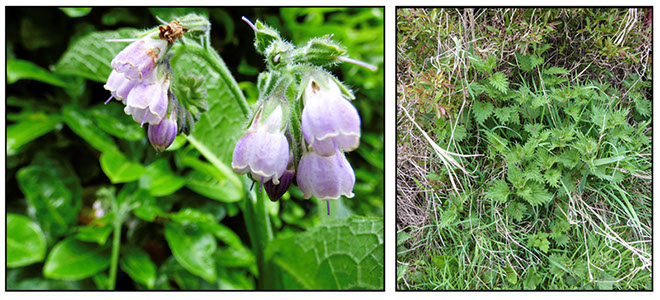
Flowers
Native flowers are the best type of flowers for wildlife but many fruit bushes and trees also provide excellent sources of nectar for beneficial insects. If herbs are allowed to flower these are often rich in nectar. Different colours and flower shapes should be chosen as this will attract a wider range of creatures. For example some bees prefer tube shaped flowers whilst other prefer daisy type flowers.
Plot
Flowers are grown for cutting but are also chosen with beneficial insects in mind. Sunflowers, cosmos and foxgloves are all regularly visited by insects. Sunflower seed heads are left for birds and small mammals. Native wildflowers such as primroses and cowslips have been planted and self sown wild species are allowed to grow in the grass around the base of the fruit trees.
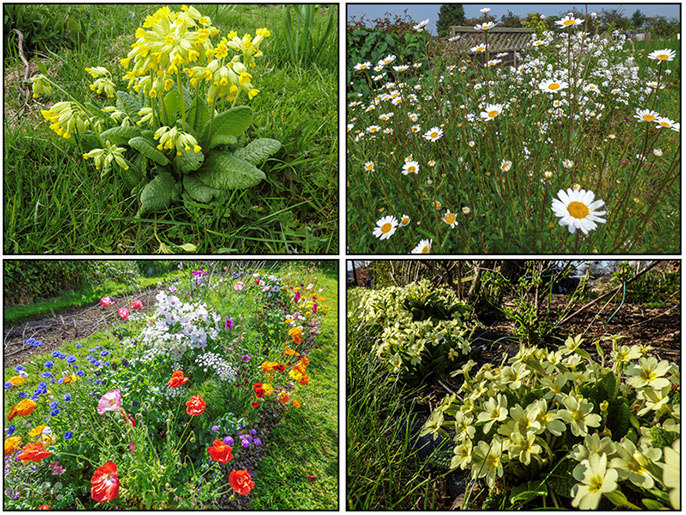
Garden
Again flowers are not only chosen for their attractiveness but also to provide feeding stations for beneficial insects.
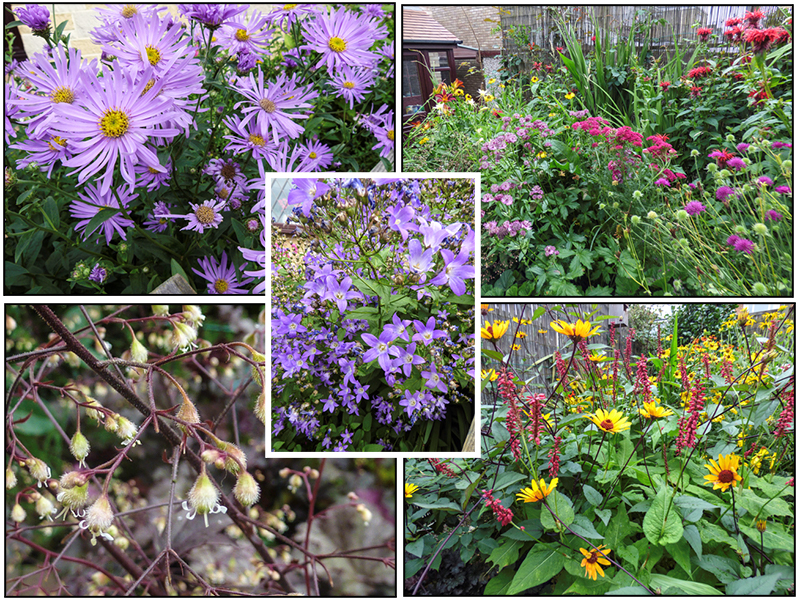
Log and Stone Piles
These provide habitats for many beneficial creatures. Beetles and centipedes will be found amongst small piles of stones. A larger pile may house frogs, toads, newts and slow-worms and maybe even the occasional stoat or weasel. Stones also provide anvils on which song thrushes can shatter snail shells. Log piles provide habitats for a number of beneficial creatures.
Plot
There are piles of logs in several areas on the plots and also piles of stone that have been dug from the beds.
Click here for more about our log pile
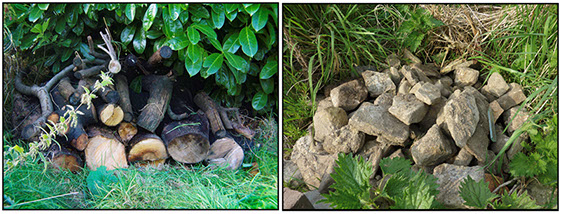
Garden
Large logs are hidden under mature shrubs.
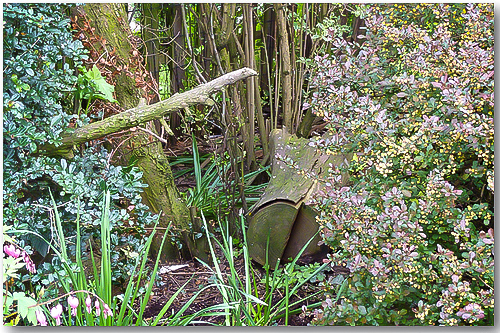
Compost Heap
All allotment plots will have some sort of compost heap which will be the home to many invertebrates many of which will be actively helping to decompose the material placed on the heap. Other creatures such as frogs, toads and hedgehogs will be drawn to the warmth of the heap during winter. Care should always be taken when moving heaps so as not to injure any creature that maybe sheltering. For the same reason care should also be taken when having a bonfire. Always move the debris before setting it alight.
Plot
As well as compost heaps we also sometimes protect plants with a covering of straw over winter. On removing these we have found nesting hedgehogs and bumblebees. We have also found wasps nests in our compost heap. Although most people probably wouldn’t want to encourage wasps they are really the gardeners friend and dispose of many aphids and caterpillars. We leave them alone as long as they don’t decide to nest to closely to where they may pose a threat.
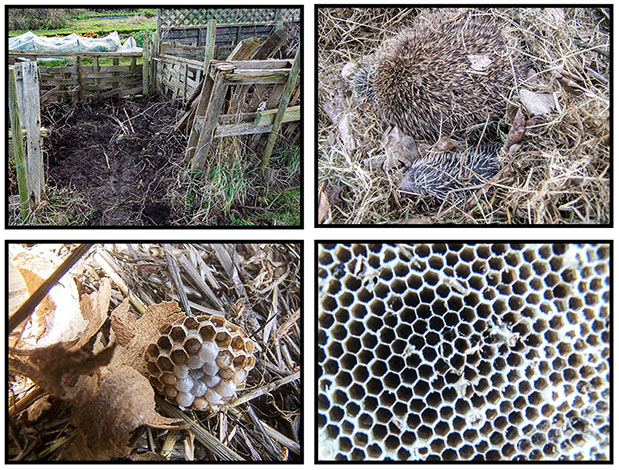
Feeding Stations
Plot
As feeding stations really need to provide food on a regular basis and as we don't visit the plot every day we don't provide these on the plot.
Garden
We try to provide a variety of food to attract and supply a variety of birds. We have three bird tables, two roofed and one open, two tables are situated close to a tree which allows cover for birds waiting to visit the tables or when they feel under threat. We have a sparrowhawk visitor. There are also a couple of ground feeding stations for those birds that prefer to feed from the ground and several types of hanging feeders all providing a wide variety of food types.
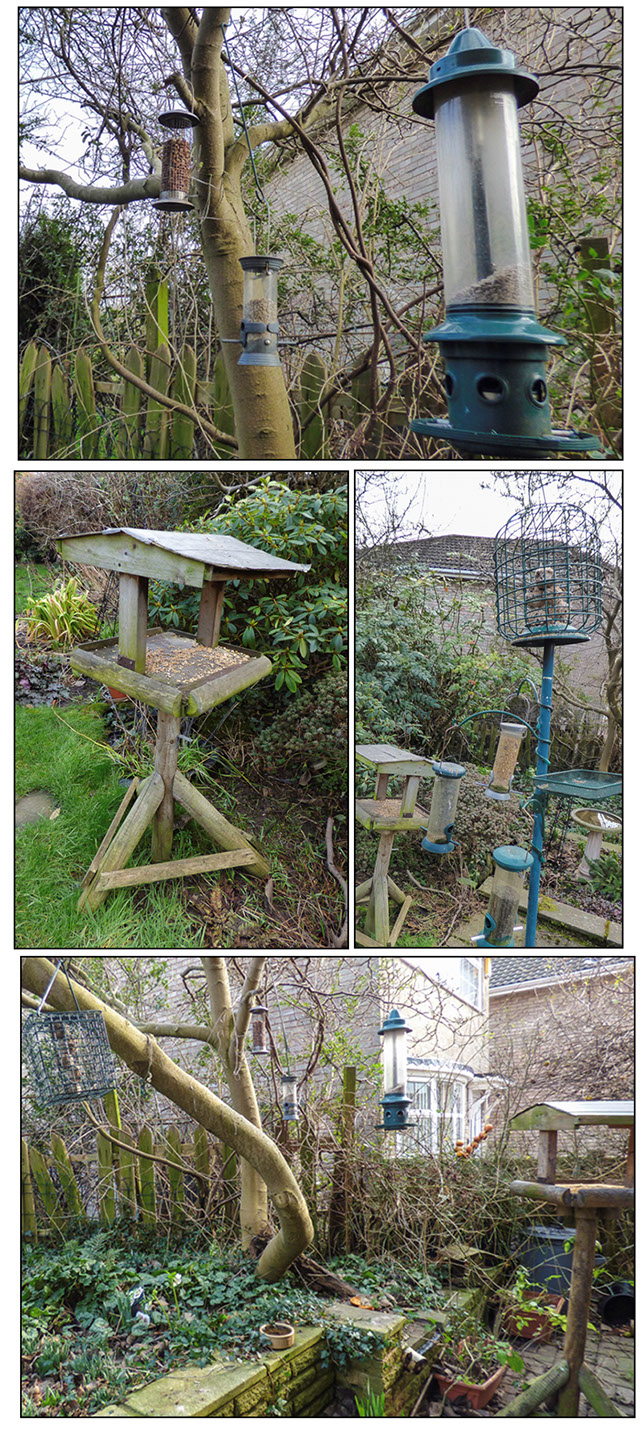
Nest Boxes
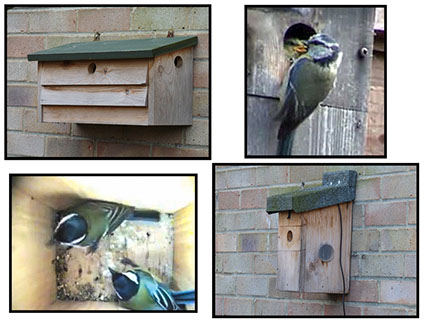
Garden
We have quite a number of nesting boxes but the birds are very unpredictable in their choice of box. We put up a couple of sparrow terraces which have only ever been used by blue tits and great tits. The holes should be too big for their comfort but they don’t appear to have noticed this. I think maybe the boxes should be placed higher but that would make maintenance difficult.
One of our boxes has a nest box camera. Click here to view the latest films
Bug Hotels
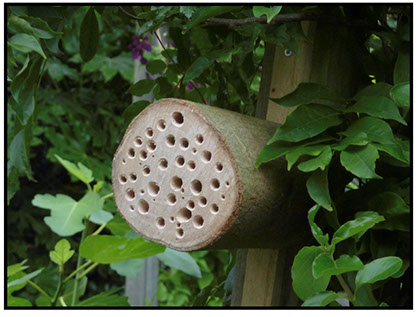 Although there are many suitable habitats for invertebrates on our plot and in our garden we decided to create a bee block. for solitary bee motels.
Although there are many suitable habitats for invertebrates on our plot and in our garden we decided to create a bee block. for solitary bee motels.
For details of how it was made click here
If you don't want to make your own you can buy ready made bee nesting boxes see here
Our Plot at Green Lane Allotments Blog | A Gardener's Weather Diary | School Vegetable Patch Website
© Our Plot on Green Lane Allotments - Please email me if you wish to use any of this site's content